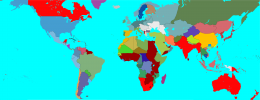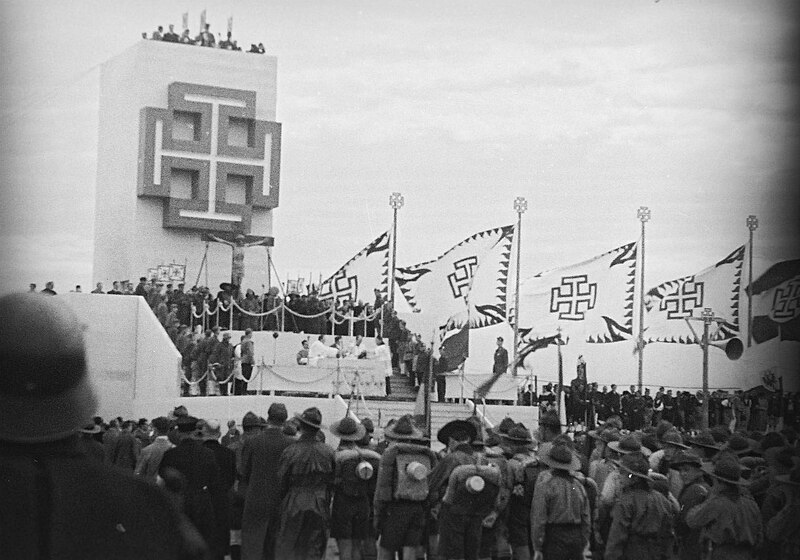Chapter 9: Thai victory in Laos, the Great Indochina Game
Chapter 9: Thai victory in Laos, the Great Indochina Game
Lasting barely three months, the majority spent cleaning up the regions of partisans and freedom fighters, Siam had conquered the whole territory of Laos. It had barely lost 700 men from an invasion force of 60 thousand men. Some guerrilla units would strike against some military facilities, but Laos would be considered completely secured by the end of the 40's. Siam would not become a member of the Axis, but was considered friendly towards them none the less.

Asia after the Laos-Thai war
After these initial conflicts, peace in the world seemed to return to normal. There were minimal revolts in either colonies or new states, but for the most part, there were no major conflicts worldwide. This was also thanks to two factors. The first was the creation of the Atomic Bomb, an explosive device that derives its destructive force from nuclear reactions, either fission (fission bomb) or from a combination of fission and fusion reactions (thermonuclear bomb). It was capable of destroying cities with a single explosion. Germany developed it first and tested it in the Lybian desert with Italian authorization. The US followed shortly with a test in New Mexico. Now, any war could result in the end of the human race if so many of these bombs were mass produced. The second reason was the United Nations becoming far more involved in international affairs, placing embagues or humanitarian aids in many conflics that would follow the early 40's. One such example was the Great Indochina Game.
For Great Indochina Game we referr to a serie of proxy wars between the Axis and the Allies for controll of Indochina. By 1945, the Axis had friendly governments in Siam and Cambodia, while the Allies had a democratic frienly Vietnamese and Khmer state and direct controll of Burma (thanks to British Burma) and Malaysia (thanks to British Malaysia). So far, the balance of power seemed to be stocked on the Allies side, with four out of the six regions of the Indochinese peninsula being pro-allies. Japan had managed to pressure Siam to become friendly towards the Axis, mostly thanks to the fact that Siam was farely isolated and feared for an Allied intervention. Cambodia itself had become an Axis friendly state with the rise of the Kingdom of Cambodia. However, for the Japanese, the major Axis power in Asia, it was relatively hard to support their Indochinese allies. Plans for support of anti Allies government in Liangguang also called for ways to turn Vietnam in a pro-Axis government. On October 1945, the Việt Nam Quốc Dân Đảng, the Nationalist Party of Vietnam, also known as Việt Quốc, begun massive operations in southern Vietnam, moving from Cambodia. This group was heavily supported by the Japanese and the Cambodians, the latter wishing to integrate the Khmer republic. Scared of losing Liangguang as an important ally if Vietnam was to become pro-Axis, Britain was the first to react in support of the Vietnamese government. There were even talks of sending a British expeditionary force against the Việt Quốc.

The Political Situation in Asia, October 1945
Vote Here:
Allies Course of Action:

 www.strawpoll.me
www.strawpoll.me
Axis Course of Action:

 www.strawpoll.me
www.strawpoll.me
United Nations Course of Action:

 www.strawpoll.me
www.strawpoll.me
I hope you guys like this new update! Be sure to like(if you like it), comment(please comment so I can learn what your opinion is) and.....follow I guess.
Lasting barely three months, the majority spent cleaning up the regions of partisans and freedom fighters, Siam had conquered the whole territory of Laos. It had barely lost 700 men from an invasion force of 60 thousand men. Some guerrilla units would strike against some military facilities, but Laos would be considered completely secured by the end of the 40's. Siam would not become a member of the Axis, but was considered friendly towards them none the less.
Asia after the Laos-Thai war
After these initial conflicts, peace in the world seemed to return to normal. There were minimal revolts in either colonies or new states, but for the most part, there were no major conflicts worldwide. This was also thanks to two factors. The first was the creation of the Atomic Bomb, an explosive device that derives its destructive force from nuclear reactions, either fission (fission bomb) or from a combination of fission and fusion reactions (thermonuclear bomb). It was capable of destroying cities with a single explosion. Germany developed it first and tested it in the Lybian desert with Italian authorization. The US followed shortly with a test in New Mexico. Now, any war could result in the end of the human race if so many of these bombs were mass produced. The second reason was the United Nations becoming far more involved in international affairs, placing embagues or humanitarian aids in many conflics that would follow the early 40's. One such example was the Great Indochina Game.
For Great Indochina Game we referr to a serie of proxy wars between the Axis and the Allies for controll of Indochina. By 1945, the Axis had friendly governments in Siam and Cambodia, while the Allies had a democratic frienly Vietnamese and Khmer state and direct controll of Burma (thanks to British Burma) and Malaysia (thanks to British Malaysia). So far, the balance of power seemed to be stocked on the Allies side, with four out of the six regions of the Indochinese peninsula being pro-allies. Japan had managed to pressure Siam to become friendly towards the Axis, mostly thanks to the fact that Siam was farely isolated and feared for an Allied intervention. Cambodia itself had become an Axis friendly state with the rise of the Kingdom of Cambodia. However, for the Japanese, the major Axis power in Asia, it was relatively hard to support their Indochinese allies. Plans for support of anti Allies government in Liangguang also called for ways to turn Vietnam in a pro-Axis government. On October 1945, the Việt Nam Quốc Dân Đảng, the Nationalist Party of Vietnam, also known as Việt Quốc, begun massive operations in southern Vietnam, moving from Cambodia. This group was heavily supported by the Japanese and the Cambodians, the latter wishing to integrate the Khmer republic. Scared of losing Liangguang as an important ally if Vietnam was to become pro-Axis, Britain was the first to react in support of the Vietnamese government. There were even talks of sending a British expeditionary force against the Việt Quốc.
The Political Situation in Asia, October 1945
Vote Here:
Allies Course of Action:

Allies Course of Action:
Vote Now! [Send troops to Vietnam] [Support Vietnam with weapons] [Give humanitarian aids] [Do nothing]
Axis Course of Action:

Axis Course of Action
Vote Now! [Send troops in support of the Việt Quốc] [Send weapons to the Việt Quốc] [Give humanitarian aids] [Do nothing]
United Nations Course of Action:

UN Course of Action
Vote Now! [Create a Peacekeeping task to Vietnam] [Send humanitarian aids] [Do nothing]
I hope you guys like this new update! Be sure to like(if you like it), comment(please comment so I can learn what your opinion is) and.....follow I guess.
















